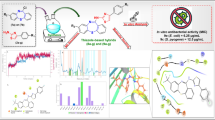Abstract
The present study is aimed at combining two well-known pharmacophores (pyrazoline and benzoxazole nucleus) to design and synthesize a series of new benzoxazole-based pyrazoline derivatives. In vitro antitubercular evaluation against Mycobacterium tuberculosis H37Rv and multidrug-resistant TB (MDR-TB) strains showed that most of the target compounds displayed potent activity (MIC ~0.625–25 μg/mL). Few compounds were found to be better than isoniazid against MDR-TB (MIC = 3.25 μg/mL). In order to gain insights into the plausible binding motifs, the target compounds were docked into enoyl-acyl carrier protein (ACP) reductase, a molecular target of isoniazid. Many compounds were successfully docked into the active site of enoyl-ACP reductase and all the docked compounds occupied the same hydrophobic binding pocket and interacted mostly by dispersion interactions with the neighboring residues Met103, Met155, Tyr158, Met199, Ile202, Ile215, and Leu218. Contribution of the three pharmacophoric fragments (pyrazoline, benzoxazole and aryl ring) towards protein–ligand binding was evaluated at semi-empirical quantum mechanics level. The interaction energies suggested that most of the binding was governed by the benzoxazole moiety followed by pyrazoline and aryl rings.



Similar content being viewed by others
References
Abdel-Wahab BF, Abdel-Latif E, Mohamed HA, Awad GE (2012) Design and synthesis of new 4-pyrazolin-3-yl-1,2,3-triazoles and 1,2,3-triazol-4-yl-pyrazolin-1-ylthiazoles as potential antimicrobial agents. Eur J Med Chem 52:263–268
Ahsan MJ, Govindasamy J, Khalilullah H, Mohan G, Stables JP, Pannecouque C, De Clercq E (2012) POMA analyses as new efficient bioinformatics’ platform to predict and optimise bioactivity of synthesized 3a,4-dihydro-3H-indeno[1,2-c]pyrazole-2-carboxamide/carbothioamide analogues. Bioorg Med Chem Lett 22:7029–7035
Bandgar BP, Adsul LK, Chavan HV, Jalde SS, Shringare SN, Shaikh R, Meshram RJ, Gacche RN, Masand V (2012) Synthesis, biological evaluation, and docking studies of 3-(substituted)-aryl-5-(9-methyl-3-carbazole)-1H-2-pyrazolines as potent anti-inflammatory and antioxidant agents. Bioorg Med Chem Lett 22:5839–5844
Brahmkshatriya PS, Dobeš P, Fanfrlík J, Rezáč J, Paruch K, Bronowska A, Lepšík M, Hobza P (2013) Quantum mechanical scoring: structural and energetic insights into cyclin-dependent kinase 2 inhibition by pyrazolo[1,5-a]pyrimidines. Curr Comput Aided Drug Des 9:118–129
Dye C, Lönnroth K, Jaramillo E, Williams BG, Raviglione M (2009) Trends in tuberculosis incidence and their determinants in 134 countries. Bull World Health Organ 87:683–691
Friesner RA, Murphy RB, Repasky MP, Frye LL, Greenwood JR, Halgren TA, Sanschagrin PC, Mainz DT (2006) Extra precision glide: docking and scoring incorporating a model of hydrophobic enclosure for protein–ligand complexes. J Med Chem 49:6177–6196
He X, Alian A, Stroud R, de Montellano PRO (2006) Pyrrolidine carboxamides as a novel class of inhibitors of enoyl acyl carrier protein reductase from mycobacterium tuberculosis. J Med Chem 49:6308–6323
KočíJ, Klimešová V, Waisser K, Kaustová J, Dahse H-M, Möllmann U (2002) Heterocyclic benzoxazole derivatives with antimycobacterial in vitro activity. Bioorg Med Chem Lett 12:3275–3278
Manna K, Agrawal YK (2010) Design, synthesis, and antitubercular evaluation of novel series of 3-benzofuran-5-aryl-1-pyrazolyl-pyridylmethanone and 3-benzofuran-5-aryl-1-pyrazolylcarbonyl-4-oxo-naphthyridin analogs. Eur J Med Chem 45:3831–3839
Mohan SB, Kumar BVVR, Dinda SC, Naik D, Seenivasan SP, Kumar V, Rana DN, Brahmkshatriya PS (2012) Microwave-assisted synthesis, molecular docking and antitubercular activity of 1,2,3,4-tetrahydropyrimidine-5-carbonitrile derivatives. Bioorg Med Chem Lett 22:7539–7542
Pearlman DA, Charifson PS (2001) Are free energy calculations useful in practice? A comparison with rapid scoring functions for the P38 MAP kinase protein system. J Med Chem 44:3417–3423
Shaharyar M, Siddiqui AA, Ali MA (2006) Synthesis and evaluation of phenoxy acetic acid derivatives as anti-mycobacterial agents. Bioorg Med Chem Lett 16:4571–4574
Sharma S, Sharma PK, Kumar N, Dudhe R (2011) A review on various heterocyclic moieties and their antitubercular activity. Biomed Pharmacother 65:244–251
Siddiqui ZN, Musthafa TN, Ahmad A, Khan AU (2011) Thermal solvent-free synthesis of novel pyrazolyl chalcones and pyrazolines as potential antimicrobial agents. Bioorg Med Chem Lett 21:2860–2865
Stover CK, Warrener P, VanDevanter DR, Sherman DR, Arain TM, Langhorne MH, Anderson SW et al (2000) A small-molecule nitroimidazopyran drug candidate for the treatment of tuberculosis. Nature 405:962–966
Temiz-Arpaci O, Yildiz I, Ozkan S, Kaynak F, Aki-Sener E, Yalçin I (2008) Synthesis and biological activity of some new benzoxazoles. Eur J Med Chem 43:1423–1431
Udwadia ZF, Amale RA, Ajbani KK, Rodrigues C (2012) Totally drug-resistant tuberculosis in India. Clin Infect Dis 54:579–581
Vinsova J, Cermakova K, Tomeckova A, Ceckova M, Jampilek J, Cermak P, Kunes J, Dolezal M, Staud F (2006) Synthesis and antimicrobial evaluation of new 2-substituted 5,7-di-tert-butylbenzoxazoles. Bioorg Med Chem 14:5850–5865
Acknowledgments
One of the authors (D. N. Rana) is thankful to UGC-BSR for Research fellowship.
Author information
Authors and Affiliations
Corresponding authors
Electronic supplementary material
Below is the link to the electronic supplementary material.
Rights and permissions
About this article
Cite this article
Rana, D.N., Chhabria, M.T., Shah, N.K. et al. Discovery of new antitubercular agents by combining pyrazoline and benzoxazole pharmacophores: design, synthesis and insights into the binding interactions. Med Chem Res 23, 2218–2228 (2014). https://doi.org/10.1007/s00044-013-0815-x
Received:
Accepted:
Published:
Issue Date:
DOI: https://doi.org/10.1007/s00044-013-0815-x




